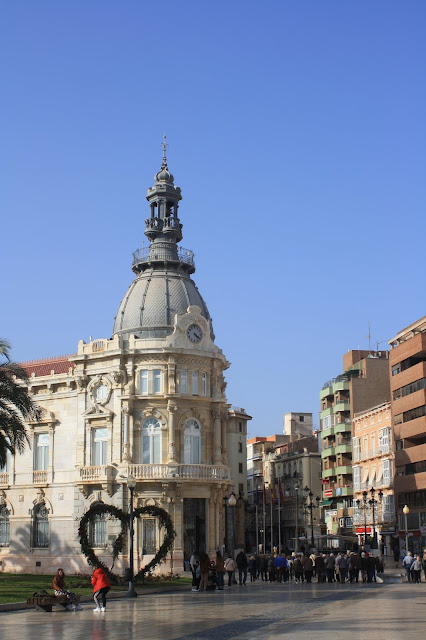The easiest and quickest way to get from Isla Plana to Cartagena would be to sail there. The city is only a few kilometres beyond the Cabo Tiñoso which we can see out of our window. However the headland is precipitous and there is no road along the coast. There is a minor road across its flank, making it less than 20 kilometres to the city, but I did not like the look of the hairpin bends marked on the map. Instead we headed back to Mazarron and took the N322, the old main road. It was twice the distance but would bring us to the northern edge of the city where the 'camping autocaravanas' is located.
Many of Spain's former main roads have been superseded by autovia. Most are quiet and offer a more attractive alternative route to the motorway. This one followed an empty valley covered in bright yellow patches of spring flowers and the waysides were lined with almond blossom. Half way up the valley a shepherd had paused by the roadside, his mixed herd of sheep and goats behind him meandering up the barren hill. One of the delights of travel in the Mediterranean is the sight of wandering pastoralists walking with their flocks. Back home shepherds are more likely to use quad bikes. There is something elemental about the scene. Pockets of transhumanism still exist all over Europe. Though more common in the mountains of Cantabria, Spain's scrubby uplands means small scale herding goes on in many out of the way places just as it has for the past 8000 years.
These romantic musings were brought to earth with a bump as we reached Cartagena's outskirts. Not busy, but still dealing with urban traffic takes vigilance. Even so I missed a turning and ended up heading into the city centre. I almost reached it before I spotted a roundabout safe enough to do a U turn. We were heading for Cartagena's 'Area Autocaravanas', which we eventually found. We have stayed here before, it's an excellent place, partly due to the enthusiasm of the owner. Therese is something of a star among the moho fraternity, she greeted Gill like a long list friend, 'Welcome back!' Therese exclaimed, 'I remember you ' It would be remarkable if she did, we were last here in 2014.
We had planned to arrive before lunch so we could visit Cartagena in the afternoon, then move on the next day. 'You must stay tomorrow' Therese insisted, 'it is the first day of the Carnival and there will be a parade.' She handed us a programme, the entire event stretched over 10 days. It would be great to see the opening at least, we agreed..
We headed into the city in the early afternoon. There is a bus every fifteen minutes. It should be simple as the stop is only about 300 metres from the camperstop but it involves walking down a narrow road with no pavements used by local petrolheads as shortcut. It is a bit hair raising.
I wanted to visit the museum of underwater archaeology. It showcases artefacts from Phoenician trading vessels that had been discovered nearby. Ever since I read Cyprien Broodbank's 'The Middle Sea' I have become increasingly intrigued by them; they were the 'dark horses' of the ancient world, the people who first linked eastern and western Mediterranean culture, precursors of the Roman notion of Mare Nostrum.
The place has more information about subaqua archaeological methods and interactive displays, models and replicas than actual artefacts, nevertheless it was worthwhile and the museum itself is modern and interestingly designed.
It was barely mid-afternoon when we emerged. What next? On our previous visit to Cartagena we had climbed up to the castle and visited the area around the Roman theatre. We headed today for another archaeological area - the 'quartier du forum Romain Molinete'. The remains of a large bathhouse complex, shrines and cult banqueting rooms are protected by a large roof, this is necessary because vestiges of the the original decorated plasterwork is still visible.
It was barely mid-afternoon when we emerged. What next? On our previous visit to Cartagena we had climbed up to the castle and visited the area around the Roman theatre. We headed today for another archaeological area - the 'quartier du forum Romain Molinete'. The remains of a large bathhouse complex, shrines and cult banqueting rooms are protected by a large roof, this is necessary because vestiges of the the original decorated plasterwork is still visible.
It would be wrong to regard Cartagena as only interesting for its ancient remains. The modern city has an intriguing mix of buildings from Modernista through to the Postmodern - more of an engaging jumble than a coherent design. We promised to concentrate on today's Cartegena tomorrow, the first parade of the Carnival kicked off at 5.30pm. so we had a whole afternoon in store to wander about some more













No comments:
Post a Comment